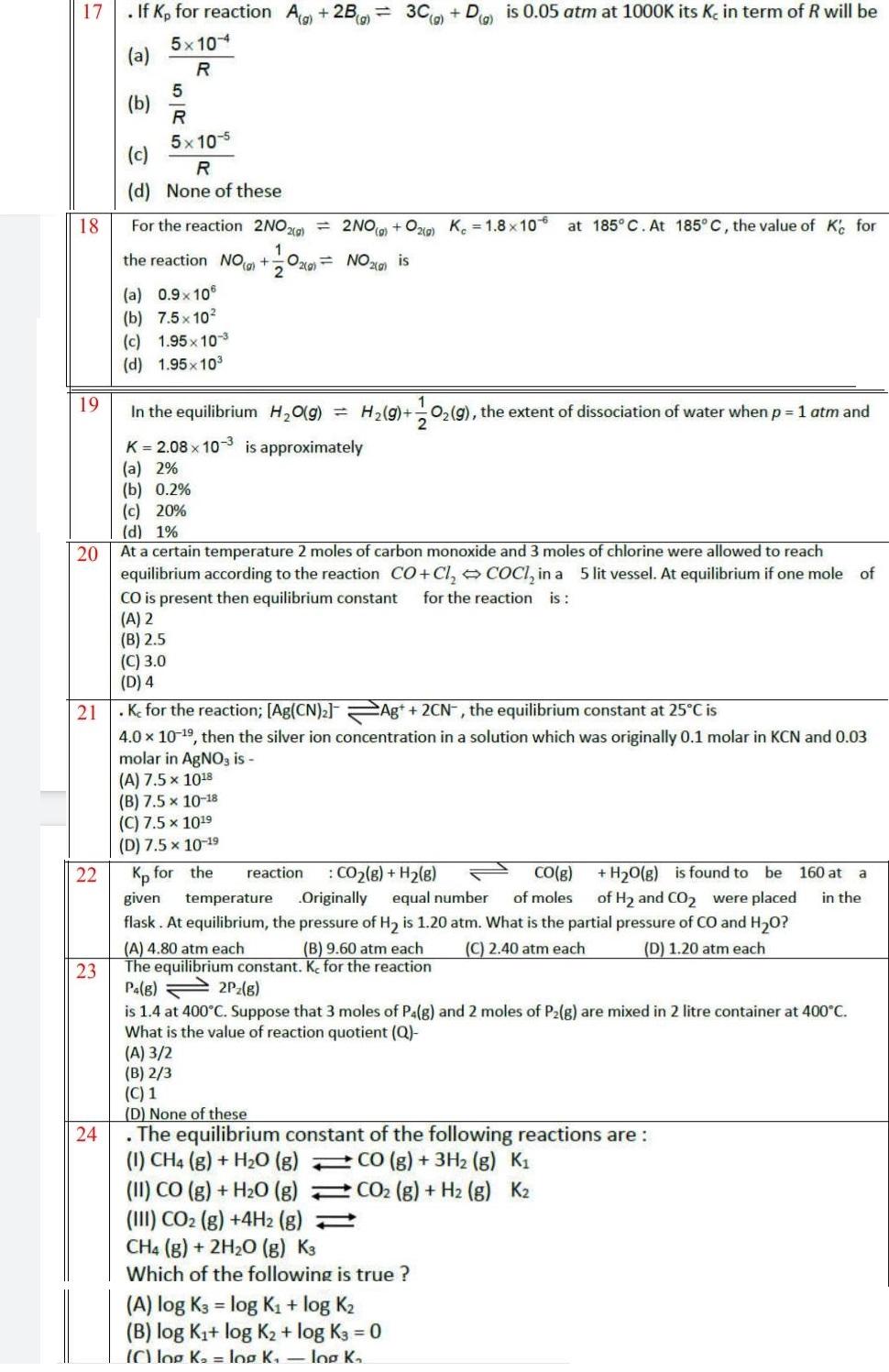Answered step by step
Verified Expert Solution
Question
1 Approved Answer
17 . If K, for reaction Ag +2B = 3C) + D. (), is 0.05 atm at 1000K its K, in term of R

17 . If K, for reaction Ag +2B = 3C) + D. (), is 0.05 atm at 1000K its K, in term of R will be (g) 5x 104 (a) R 5 (b) 5x 10-5 (c) R (d) None of these 18 For the reaction 2NOx) = 2NO() + O, K. = 1.8 x 106 at 185 C. At 185 C, the value of K for the reaction NO +Oxo) = NOx is 2(9) (a) 0.9x 10 (b) 7.5 x 10? (c) 1.95x 10s (d) 1.95x103 19 In the equilibrium H,0(g) = H2(g)+O2(g), the extent of dissociation of water when p 1 atm and K = 2.08 x 103 is approximately (a) 2% (b) 0.2% (c) 20% (d) 1% At a certain temperature 2 moles of carbon monoxide and 3 moles of chlorine were allowed to reach 20 equilibrium according to the reaction CO+Cl, COCI, in a 5 lit vessel. At equilibrium if one mole of CO is present then equilibrium constant (A) 2 (B) 2.5 (C) 3.0 (D) 4 for the reaction is: 21 . Ke for the reaction; [Ag(CN)2] Agt + 2CN-, the equilibrium constant at 25C is 4.0 x 10-19, then the silver ion concentration in a solution which was originally 0.1 molar in KCN and 0.03 molar in AgNO, is - (A) 7.5 x 1018 (B) 7.5 x 10-18 (C) 7.5 x 1019 (D) 7.5 x 10-19 : CO2(8) + H2(8) + H20(g) is found to be 160 at a in the 22 Kp for the reaction CO(g) given temperature .Originally equal number of moles of H2 and CO2 were placed flask. At equilibrium, the pressure of H2 is 1.20 atm. What is the partial pressure of CO and H20? (C) 2.40 atm each (A) 4.80 atm each The equilibrium constant. K. for the reaction (B) 9.60 atm each (D) 1.20 atm each 23 Pa(e) 2P:(gs) is 1.4 at 400C. Suppose that 3 moles of Pa(g) and 2 moles of P2(g) are mixed in 2 litre container at 400C. What is the value of reaction quotient (Q)- (A) 3/2 (B) 2/3 (C) 1 (D) None of these 24 . The equilibrium constant of the following reactions are : (1) CH4 (g) + H2O (g) CO (g) + 3H2 (g) K1 (II) CO (g) + H20 (g) 2 CO2 (g) + H2 (g) K2 (III) CO2 (g) +4H2 (g) CH4 (g) + 2H20 (g) K3 Which of the following is true ? (A) log K3 = log K1 + log K2 (B) log Ki+ log K2 + log K3 = 0 IC log Ka = log K. log K.
Step by Step Solution
★★★★★
3.46 Rating (153 Votes )
There are 3 Steps involved in it
Step: 1

Get Instant Access to Expert-Tailored Solutions
See step-by-step solutions with expert insights and AI powered tools for academic success
Step: 2

Step: 3

Ace Your Homework with AI
Get the answers you need in no time with our AI-driven, step-by-step assistance
Get Started


